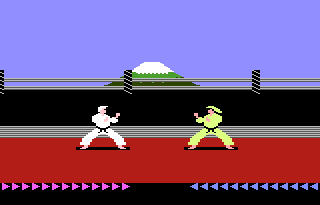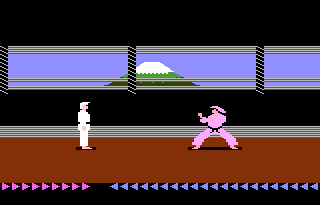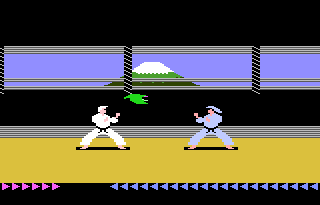|
|
Karateka
|
Name:
|
Karateka |
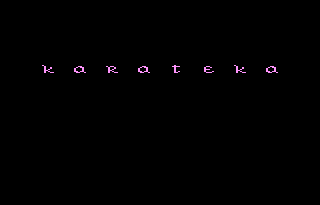 |
| Company: | Atari | |
|
Model #:
|
CX-7822 | |
|
Programmer:
|
Jack Sandberg (ibid Inc.) | |
| Year: | 1988 | |
|
Released?
|
Yes
|
|
|
Notes:
|
Original game design by Jordan Mechner who later went on to create Prince of Persia |
If you were around during the mid-80's, then you probably remember a little Apple IIe game called Karateka. Karateka was one of the finest side scrolling fighting games ever to grace the Apple, and quickly became the 'must have' game of the year. Karateka was also famous for its "deadly ending" in which the player can be killed by the very person he's trying to save (the beautiful Princess Mariko). If the player approaches the Princess while still in his fighting stance she will kick and kill him, the only way to win the game is to run into her arms. One has to wonder how many people threw their joysticks at the screen in frustration after being killed this way.
After the initial Apple IIe version, Karateka was later released for the Atari 400/800, Atari XE, Commodore 64, IBM, and unfortunately, for the Atari 7800. Now at this point you're probably wondering why it was a bad thing for Karateka to be released for the 7800. Well let's just say that while the idea was good, the execution was terrible. Someone at ibid inc. dropped the ball when they made this port, not only did they skimp on the graphics (who the hell chose those colors?), but they needlessly complicated the controls. To get a feeling as to how bad the controls are in the 7800 version of Karateka, you really need to compare them to the original Apple setup.
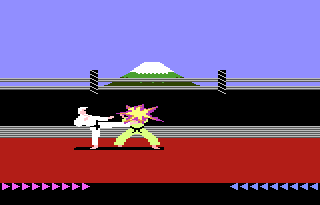
In the Apple version the player simply had push left or right to walk, push up to stand, and up/left to run. Letting the joystick center would bring the player to the 'fighting stance'. Pushing the top joystick button while pushing up/left, left, or down/left would perform the three types of punches, while using the bottom joystick button would perform the three types of kicks. This control scheme takes seconds to learn and is very intuitive. Now since the 7800 has two buttons just like the Apple, one would think the programmer would use the same control scheme. Then again if you knew ibid, you'd realize that that would have been too easy. Instead they chose to implement their own complicated control scheme which continues to frustrate gamers to this day.
In the 7800 control scheme pushing the right button makes you assume your fighting stance (when standing), and pushing right makes you run forward. When in the fighting stance, holding down the left button while pushing right or left makes you walk. Pushing right, up/right, or down/right (while not holding down the button) makes you kick, and pushing left, up/left, or down/left (while not holding down the button) makes you punch. Pushing the right button makes you stand again. Got all that? This control scheme was so confusing Atari had to print a reference chart on the back of the manual. Now if Atari goes through the hassle of printing out a chart you know it has to bad...
Bad controls and questionable colors aren't the only things wrong with the 7800 version of Karateka. There are numerous collision detection issues that make hitting your opponent at close range nearly impossible, couple this with choppy animation and missing graphical 'extras' (which were found in every other version), and you've got a recipe for disaster. Poor programming attempts like this were one of the main reasons the 7800 never had a fighting chance (no pun intended).
| Version | Cart Text | Description |
| 10/15/86 | Version 1.0 | |
| 12/23/86 | Karateka 12/23/86 | Very close to final |

